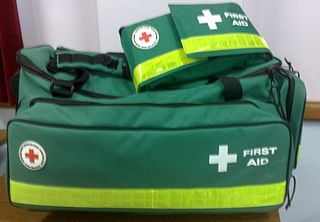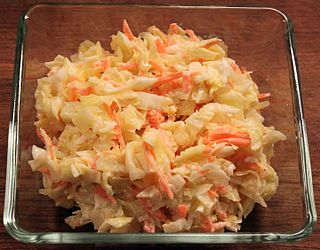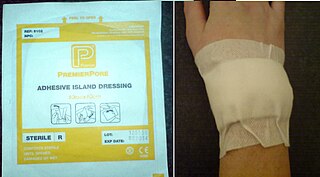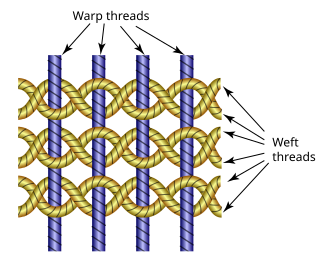
Biopolymers are natural polymers produced by the cells of living organisms. Biopolymers consist of monomeric units that are covalently bonded to form larger molecules. There are three main classes of biopolymers, classified according to the monomers used and the structure of the biopolymer formed: polynucleotides, polypeptides, and polysaccharides. Polynucleotides, such as RNA and DNA, are long polymers composed of 13 or more nucleotide monomers. Polypeptides and proteins, are polymers of amino acids and some major examples include collagen, actin, and fibrin. Polysaccharides are linear or branched polymeric carbohydrates and examples include starch, cellulose and alginate. Other examples of biopolymers include natural rubbers, suberin and lignin, cutin and cutan and melanin.
Collagen is the main structural protein in the extracellular matrix found in the body's various connective tissues. As the main component of connective tissue, it is the most abundant protein in mammals, making up from 25% to 35% of the whole-body protein content. Collagen consists of amino acids bound together to form a triple helix of elongated fibril known as a collagen helix. It is mostly found in connective tissue such as cartilage, bones, tendons, ligaments, and skin.

A salad is a dish consisting of mixed, mostly natural ingredients with at least one raw ingredient. They are often dressed, and typically served at room temperature or chilled, though some can be served warm.

Kaga (加賀) was an aircraft carrier built for the Imperial Japanese Navy (IJN) and was named after the former Kaga Province in present-day Ishikawa Prefecture. Originally intended to be one of two Tosa-class battleships, Kaga was converted under the terms of the Washington Naval Treaty to an aircraft carrier as the replacement for the battlecruiser Amagi, which had been irreparably damaged during the 1923 Great Kantō earthquake. Kaga was rebuilt in 1933–1935, increasing her top speed, improving her exhaust systems, and adapting her flight decks to more modern, heavier aircraft.

Akagi was an aircraft carrier built for the Imperial Japanese Navy (IJN), named after Mount Akagi in present-day Gunma Prefecture. Though she was laid down as an Amagi-class battlecruiser, Akagi was converted to an aircraft carrier while still under construction to comply with the terms of the Washington Naval Treaty. The ship was rebuilt from 1935 to 1938 with her original three flight decks consolidated into a single enlarged flight deck and an island superstructure. The second Japanese aircraft carrier to enter service, and the first large or "fleet" carrier, Akagi and the related Kaga figured prominently in the development of the IJN's new carrier striking force doctrine that grouped carriers together, concentrating their air power. This doctrine enabled Japan to attain its strategic goals during the early stages of the Pacific War from December 1941 until mid-1942.

The Chassepot, officially known as Fusil modèle 1866, was a bolt-action military breechloading rifle. It is famous for having been the arm of the French forces in the Franco-Prussian War of 1870–1871. It replaced an assortment of Minié muzzleloading rifles, many of which were converted in 1864 to breech loading. An improvement to existing military rifles in 1866, the Chassepot marked the commencement of the era of modern bolt action, breech-loading military rifles. The Gras rifle was an adaption of the Chassepot designed to fire metallic cartridges introduced in 1874.

A first aid kit is a collection of supplies and equipment that is used to give medical treatment. There is a wide variation in the contents of first aid kits based on the knowledge and experience of those putting it together, the differing first aid requirements of the area where it may be used, and variations in legislation or regulation in a given area.

Foie gras is a specialty food product made of the liver of a duck or goose. According to French law, foie gras is defined as the liver of a duck or goose fattened by gavage. In Spain and other countries, it is occasionally produced using natural feeding. Ducks are force-fed twice a day for 12.5 days and geese three times a day for around 17 days. Ducks are typically slaughtered at 100 days and geese at 112 days.

A bandage is a piece of material used either to support a medical device such as a dressing or splint, or on its own to provide support to or to restrict the movement of a part of the body. When used with a dressing, the dressing is applied directly on a wound, and a bandage used to hold the dressing in place. Other bandages are used without dressings, such as elastic bandages that are used to reduce swelling or provide support to a sprained ankle. Tight bandages can be used to slow blood flow to an extremity, such as when a leg or arm is bleeding heavily.

The tutu is a dress worn as a costume in a classical ballet performance, often with attached bodice. It may be made of tarlatan, muslin, silk, tulle, gauze, or nylon. Modern tutus have two basic types: the Romantic tutu is soft and bell-shaped, reaching the calf or ankle; the Classical tutu is short and stiff, projecting horizontally from the waist and hip.

Coleslaw, also known as cole slaw, New England salad, or simply slaw, is a side dish consisting primarily of finely shredded raw cabbage with a salad dressing or condiment, commonly either vinaigrette or mayonnaise. Coleslaw prepared with vinaigrette may benefit from the long lifespan granted by pickling.

A coup de grâce is a death blow to end the suffering of a severely wounded person or animal. It may be a mercy killing of mortally wounded civilians or soldiers, friends or enemies, with or without the sufferer's consent.

Silver sulfadiazine, sold under the brand Silvadene among others, is a topical antibiotic used in partial thickness and full thickness burns to prevent infection. Tentative evidence has found other antibiotics to be more effective and therefore it is no longer generally recommended for second-degree (partial-thickness) burns, but is still widely used to protect third-degree (full-thickness) burns.

French dressing, in consumer-facing American cuisine and store-bought products in the United States, is a creamy dressing that varies in color from pale orange to bright red. It is made of oil, vinegar, sugar, and other flavorings, with the coloring derived from tomato and often paprika. It exists on a spectrum between Russian and Catalina dressing.

A dressing is a sterile pad or compress applied to a wound to promote healing and protect the wound from further harm. A dressing is designed to be in direct contact with the wound, as distinguished from a bandage, which is most often used to hold a dressing in place. Many modern dressings are self-adhesive.

Gauze is a thin, translucent fabric with a loose open weave. In technical terms "gauze" is a weave structure in which the weft yarns are arranged in pairs and are crossed before and after each warp yarn keeping the weft firmly in place. This weave structure is used to add stability to fabric, which is important when using fine yarns loosely spaced. However, this weave structure can be used with any weight of yarn, and can be seen in some rustic textiles made from coarse hand-spun plant fiber yarns. Gauze is widely used for medical dressings.
The history of wound care spans from prehistory to modern medicine. Wounds naturally heal by themselves, but hunter-gatherers would have noticed several factors and certain herbal remedies would speed up or assist the process, especially if it was grievous. In ancient history, this was followed by the realisation of the necessity of hygiene and the halting of bleeding, where wound dressing techniques and surgery developed. Eventually the germ theory of disease also assisted in improving wound care.

Vinaigrette is made by mixing an oil with something acidic such as vinegar or lemon juice. The mixture can be enhanced with salt, herbs and/or spices. It is used most commonly as a salad dressing, but can also be used as a marinade. Traditionally, a vinaigrette consists of 3 parts oil and 1 part vinegar mixed into a stable emulsion, but the term is also applied to mixtures with different proportions and to unstable emulsions which last only a short time before separating into layered oil and vinegar phases.

Tree paint, also known as wound dressing, is any substance applied to damaged surfaces of a tree intended to improve its health. It is commonly applied after pruning, or at locations where the tree bark has been damaged.

















